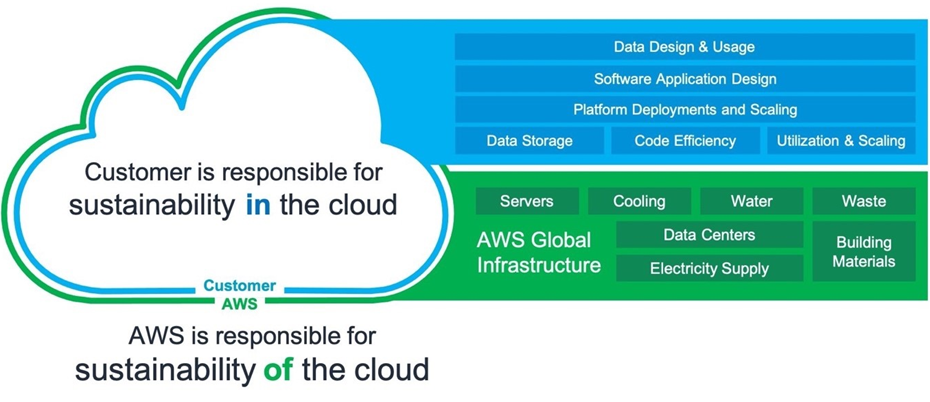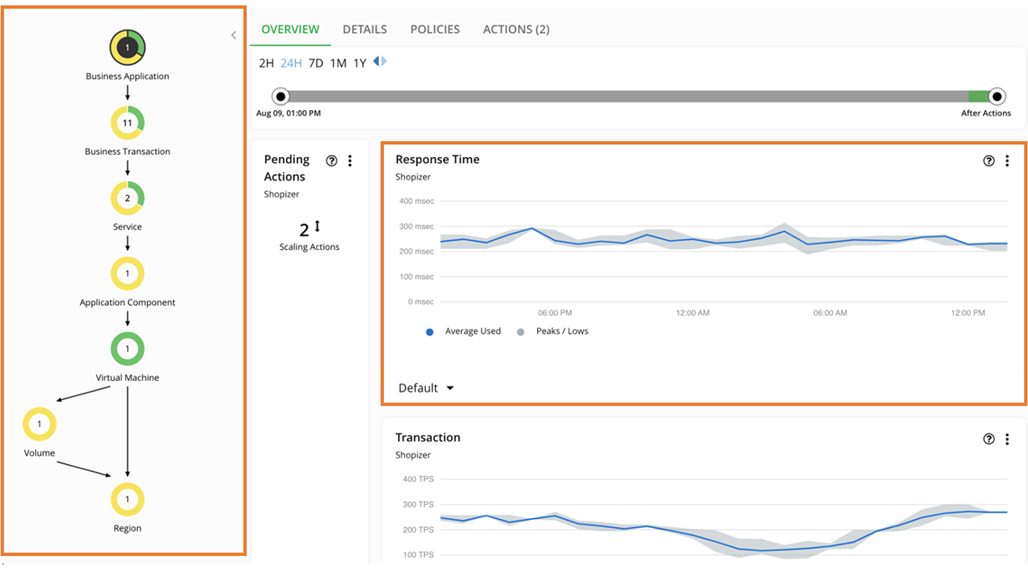AWS Partner Network (APN) Blog
Achieving Sustainable IT Through Elasticity with IBM Turbonomic and AWS
By Grace Rotondo, Alliance Manager – IBM Turbonomic
By Spencer Mehm, Product Marketing Manager – IBM Turbonomic
By Sundeep Ramachandran, Sr. Partner Solutions Architect, Sustainability – AWS
 |
| IBM Turbonomic |
 |
Cloud computing has unlocked the ability for businesses to achieve greater agility, elasticity, and speed to market.
When building cloud workloads, the practice of sustainability is to understand environmental impacts like energy consumption and apply best practices to reduce these impacts. As workloads become more complex, there is a need to continuously optimize the use of compute, storage, and network resources.
In this post, we will discuss why IT operations have become a crucial component of sustainability strategies, and how IBM Turbonomic Application Resource Management (ARM) can help Amazon Web Services (AWS) customers with sustainability in the cloud.
IBM Turbonomic is an AWS Cloud Management Tools Competency Partner whose artificial intelligence (AI)-powered Application Resource Management simultaneously optimizes performance, compliance, and cost in real time.
IT is Critical to Sustainable Business Strategies
Data centers represent the information bedrock that supports many aspects of the modern economy. Over the last decade, there has been a 15-fold increase in global internet traffic and data centers, which today account for around 1% of global electricity demand.
Governments and companies around the world are pledging to become carbon neutral, and sustainable IT is increasingly being prioritized. For example, the European Union is exploring measures to make data centers carbon neutral by 2030, and both AWS and IBM are signatories of the European Climate Neutral Data Center Pact.
Gartner predicts that by 2024, 80% of enterprises with a sustainability strategy in which IT is material will include infrastructure, operations, and cloud as a top priority for technology investments.
Sustainable IT Requires a Multifaceted Approach
Executing on strategies for sustainable IT requires pulling multiple levers. AWS takes responsibility for sustainability “of” the cloud by delivering efficient, shared infrastructure, water stewardship, and sourcing renewable power.
Customers, meanwhile, take responsibility for sustainability “in” the cloud by optimizing workloads and resource utilization, and minimizing the total resources required for the workload.
Figure 1 – AWS’s shared responsibility model for environmental sustainability.
Whatever the mix of strategies, reducing carbon emissions and overall environmental impact is not a one-off exercise and must be done continuously to be successful.
The Application Resource Management software dynamically allocates the optimal number of resources to meet application performance requirements in real time. This has helped customers reduce their cloud and data center consumption by 30% within six months, delivering measurable results as they reduce cost and carbon footprint immediately and continuously.
Operate Sustainably on AWS with IBM Turbonomic
IBM Turbonomic provides hybrid cloud optimization that supports AWS customers throughout their cloud journeys.
IBM Turbonomic software continuously ensures customers’ applications consume just what they need to perform by understanding the resource relationships at every layer of the application stack, and dynamically resourcing applications according to demand in real time.
These two components ensure IBM Turbonomic’s actions are trustworthy so they can be automated. With automation, IBM Turbonomic enables customers to unlock elasticity on AWS by consuming and returning resources as needed, delivering measurable results throughout an organization’s AWS adoption journey.
Optimize Resource Consumption
The following diagrams show the IBM Turbonomic user interface (UI). Figure 2 shows the application stack as well as the application’s real-time demand.
The process flow on the left shows the resource relationships from the business application down to the cloud region, and can include components such as containers, storage volumes, virtual machines, and more–any underlying infrastructure that supports the application.
The line chart on the right shows real-time application demand data, used to identify where there is risk due to high demand.
Figure 2 – IBM Turbonomic view of the application stack.
Below, Figure 3 shows an overview of the entire cloud environment for one AWS account. The process flow on the left shows how the entire environment is stitched together, similar to the application view in Figure 2 above.
The overview tab shows what investments are needed to restore the environment to equilibrium, in addition to what savings could be achieved if certain actions are taken. By clicking “Show All” in the Potential Savings widget, customers can see various actions that can be taken to optimize their environment, as seen in Figure 4 later in this post.
Figure 3 – IBM Turbonomic view of an AWS account.
Below, Figure 4 provides a dashboard of actions that will restore this AWS environment to optimal operation. In the dashboard, customers can see specific performance and savings actions for virtual machines.
However, customers can also execute performance, savings, efficiency and compliance actions—all of which optimize the environment’s resource consumption—for volumes, database servers, and reserved instances.
While the performance action highlighted below may increase spending to scale up a T3 instance, the savings action highlighted would offset this investment by 4x by moving to a better priced instance for the virtual machine. By creating a policy to automate these actions, customers can achieve continuous optimization across their IT environment.
Figure 4 – IBM Turbonomic action dashboard.
Cloud Migration Planning
While these images show actions for an AWS environment, IBM Turbonomic also provides resource management across hybrid and multi-cloud environments, and can deliver migration planning to help customers accelerate their cloud migrations.
Before migrating to AWS, IBM Turbonomic’s data center optimization allows for more effective use of existing assets, and its application-driven planning capabilities determine which workloads are best suited for the cloud to ensure responsible consumption immediately after migration.
As seen in Figure 5, executing on efficiency opportunities such as optimizing virtual machines from Day 1 in the cloud with IBM Turbonomic can save organizations thousands of dollars. As maturity grows and organizations host multiple business-critical applications on AWS, IBM Turbonomic continues to ensure sustainable consumption.
For organizations executing a cloud-first strategy that leverages cloud-native, platform-as-a-service (PaaS), and other cloud services, IBM Turbonomic can elastically scale modern applications based off whichever service-level objective (SLO) makes sense for their business.
In this scenario, SLO polices can be implemented so the customer’s environment automatically manages tradeoffs based off environmental impact, creating a truly sustainable elastic cloud.
Figure 5 – IBM Turbonomic migration planning with cloud cost comparison.
Achieving this level of control over the carbon impact of cloud operations should be the goal of all enterprises planning green initiatives.
IBM Hursley, a cloud-based data center located in Hampshire, England, has seen the impact of implementing IBM Turbonomic’s automation on its own carbon neutrality journey.
Colin Holyoake, an IBM Hursley Certified Datacenter Design and Sustainability Manager, said: “IBM Turbonomic can help you make sure you are fully utilizing and optimizing your infrastructure to simultaneously assure performance and minimize cost, both financially and environmentally.”
Conclusion
A Forrester study on the Total Economic Impact Report for IBM Turbonomic states that IBM Turbonomic enables customers to become elastic by achieving outcomes such as a 33% reduction in public cloud spend and carbon footprint due to dynamic scaling and workload rightsizing, and a 20% improvement in the availability of business-critical applications.
With IBM Turbonomic running on AWS, customers can uphold their sustainability responsibility in the cloud by ensuring workloads only consume exactly the resources they need to always perform. This solution helps customers minimize cost both financially and environmentally, and creates opportunities to focus on carbon footprint reduction beyond the IT environment.
IBM Turbonomic – AWS Partner Spotlight
IBM Turbonomic is an AWS Competency Partner whose AI-powered Application Resource Management simultaneously optimizes performance, compliance, and cost in real time.





